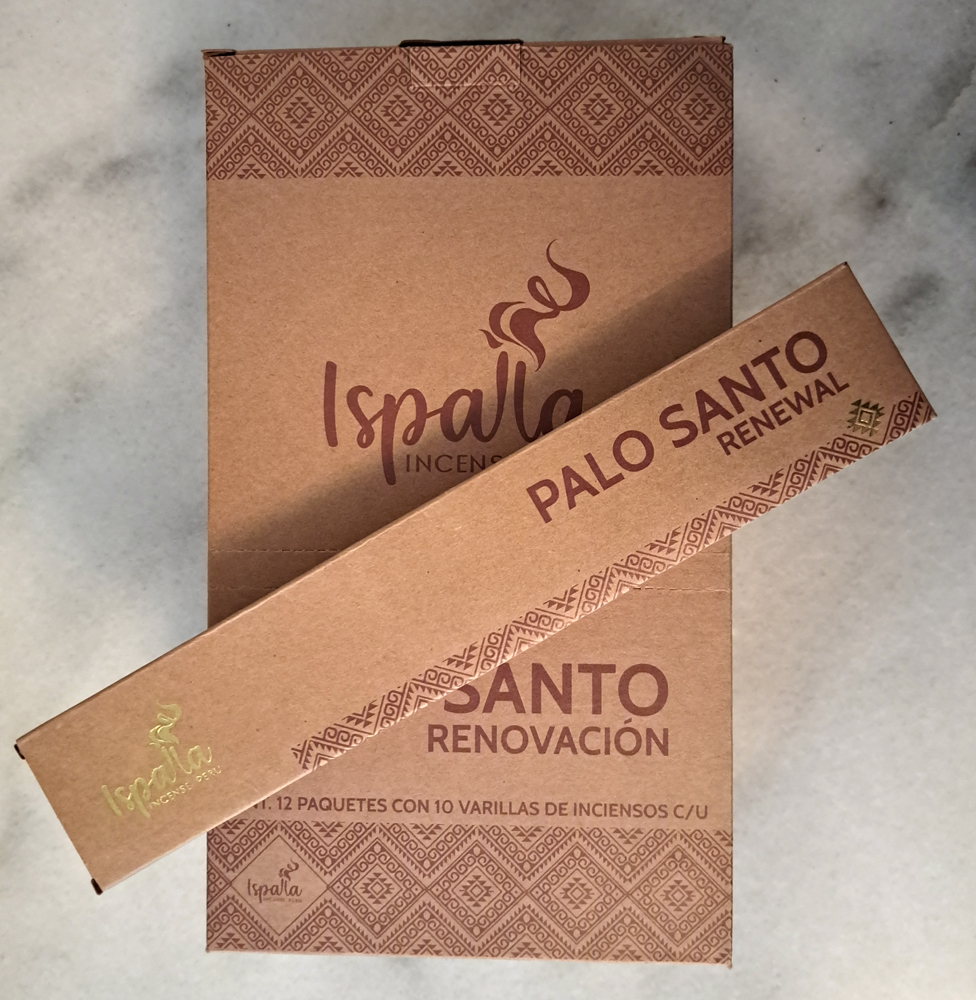Ispalla – Palo Santo
Writing this article did not come easy.
It’s not actually a review, even though I have put it in this category. It’s more of a META text.

I got these two Ispalla – Palo Santo sticks at an incense exchange.
They were my first (commercial) Palo Santo incense sticks. I have known Palo Santo as a raw material for years and have made incense sticks with it myself.
I was delighted to finally be able to try Ispalla. I’ve had the brand on my radar for quite a while. I was curious about it, but never bought some because Palo Santo isn’t one of my favourite scents. It was more of a general interest.
I read on Reddit r/Incense that their incense sticks are very authentic and smell close to pure Palo Santo wood.
Ispalla is – unlike the vast majority of other incense stick brands on the market – not an Indian company, but a Peruvian one. This means that Palo Santo is not sent halfway around the world just to process it, the incense sticks are actually produced in the country of origin.
Ispalla promotes their products as being sustainably harvested. However, they do not have a certificate, for example from the Forest Stewardship Council (FSC) or the Rainforest Alliance.
Peru has strict regulations regarding the harvesting and processing of Palo Santo. Despite this, illegal logging remains a problem with Palo Santo.
My expectations were high. The shock was even greater when I lit a stick.
The stick burned almost like a sparkler: it puffed and hissed and sprayed little sparks. Here is a (YouTube) video of it.
For me, this is a clear indication of the presence of saltpetre (potassium nitrate), which is used as an accelerant in quickly igniting coal, among other things. Anyone who knows these charcoal pucks will also know the unpleasant chemical smell – and that’s exactly how these incense sticks smell. 🙁
My first reaction was to vent my dismay on Reddit, and then decide to contact the company directly and let them know my disappointment.
A thoroughly constructive, albeit openly critical, email exchange followed.
What frustrated me about this was Ispalla‘s insistence that they do not use or have ever used saltpetre or similar accelerants.
Here is an excerpt from the first reply email:
I want to thank you for your sincere opinion, this feedback is important to us because we can improve and offer better products to our customers. I also want to mention that we don’t use chemicals, the sparks are produced because our incense have too much quantity of resin, It makes the spark and the faster burn duration. Fortunately, some lovely customers like you sent us this feedback before and we improved the formula, now our incenses burns more than 60 minutes and don’t make the spark.
Ispalla
The Ispalla employee wanted to assure me that the hissing and flying sparks came solely from the extremely high proportion of Palo Santo resin. He even made me a video (and allowed me to post it) to back it up.
Still, I think the statement is bullshit, to say the least. If I had the budget for it, I would send the sticks to a lab to prove it. But I haven’t.
What I have are many years of my experience with the raw materials that tell me that a high proportion of resin in incense sticks causes them to “drown” – the liquefying resin suffocates the embers. The more resin there is in an incense stick, the slower it burns.
Resin does not produce sparks when heated. If you actually set it on fire, mini-explosions can occur and small flash flames can be created; it crackles and puffs, but there are no sparks. No resin I’ve ever seen has ever done that.
What you see in the video are miniature smoke explosions, not sparks.
But like I said, that’s just my opinion. I have published both videos here so that everyone can form their own opinion.
Two more excerpts from the emails:
I watched some of your YouTube videos. I noticed that you like to emphasize how your incense is mostly handmade. I also noticed the formulation about how a device “help workers measure and achieve good rounded sticks”. This sounds like a purposely vague description of a semi-automated extruding process. The video also shows not a single picture of the actual manufacturing process, only clips of production steps you can rightfully say they are made by hand.
This all seems very dishonest and shades doubt on your other claims.
Rauchfane
Regarding our process, you are right, we are not showing all. We are not making our incense hand rolled now however we started making it. Fortunately, now we have more people working with us and we are acquiring products can improve our work, for example, mixers. Of course, we are updating all and “hand rolled” is not more on our packing.
Your feedback is very important, now we are working on make videos and show our process in a transparent way, so people can see the true, because we know that we have a lot of good things to show. Our intention is no to be dishonest with incense customers, our intention is to show what we really do: work with our communities, make the incense with sustainable palo santo, create more fragrances with palo santo but without chemicals.
We’re still far from being a reliable brand because of all the things you mentioned above, but it’s something we’re going to work on.
Ispalla
That sounds pretty honest and endeavoured to me.
As part of this exchange, Ispalla sent me a generous package of their improved incenses (including some new releases) with a request for honest feedback, which I am happy to give.
So far, I can say this much: I think Ispalla‘s current recipe is good. If I had gotten these incense sticks without the backstory attached to it, I wouldn’t have crossed my mind that there could be anything wrong with it. Here you can see one of the current sticks burning (YouTube).
I have already tried some of the other varieties for a first time and am satisfied with the quality, everything beyond is a matter of preference and taste.
What remains, however, is a stale aftertaste and scepticism about the company’s sincerity, at least when it comes to past versions of their products. :-/
Ispalla have not only revised the recipe, but also dramatically changed the packaging design. The brand-new packaging is no longer narrow, square and black with gold/metallic print, but natural cardboard in a fairly typical incense stick box format, as you can see on the right.
However, the recipe seems to have been already revised for some time before that change. That said, not everything in a black package has to be automatically bad.
It is difficult to say how many of the old incense sticks are still on the European market. So I advise caution when purchasing.

[2024-03-14 Update] Steve left a comment (under the German article) to point out that he had the same experience. He bought sticks with the old, black packaging from Ephra World Shop, so I have to advise against ordering them there. However, I noticed that Indiaroma recently added the new versions to their range.

The old (bottom) and new (top) incense sticks hardly differ visually at all. The old ones are slightly darker, but that could probably be just a batch variation too.
I will write separate reviews for the new Ispalla – Palo Santo RENEWAL (as well as for all the others that were sent to me) in order to let the individual Versions stand on their own and not to go beyond the scope.
This article is intended to provide the broader context.


Yikes! That is a first time seeing this for me. The video is wild. It’s like a slow burning sparkler.
Klick if you want to see another scary thing. 😬 (Sangrada Madre)